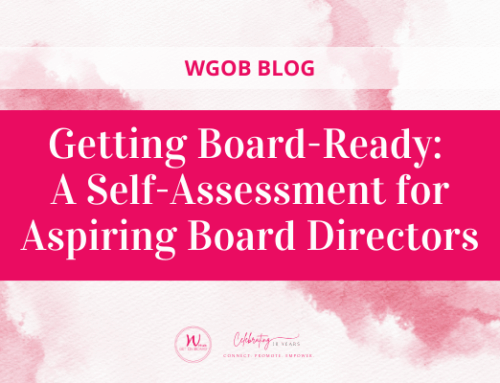
Poonam Puri is a global authority on corporate governance, financial markets regulation and ESG. A seasoned corporate director, practicing corporate/securities lawyer, former regulator, and tenured professor of business law, Poonam currently serves on the boards of CAPREIT, Propel Holdings, and the Canada Infrastructure Bank. She is also vice-chair of the board of Holland Bloorview Kids Rehabilitation Hospital in Toronto. A strategic thinker, Poonam is committed to innovation, inclusive excellence, ethical leadership and good governance. Poonam has been recognized as one of Canada’s top 25 most influential lawyers and was recently recognized with the Royal Society of Canada’s Allaire Medal for excellence in governances, as well as a BMO Celebrating Women On Boards Honouree in 2021.
How did your academic background relate to your first board appointment?
My first appointment was at the Greater Toronto Airports Authority, known as Pearson Airport. In 2008, I got a completely unexpected call from the then Mayor of Toronto who wanted to nominate me for the Pearson board. He advised that the Pearson board was looking to appoint a woman with legal and governance expertise. We had never met, so I was surprised but grateful to receive the call. It turns out that the General Counsel of my university recommended me. She knew me and my work and had seen me in action.
The board was looking for particular skills and competencies as well as broader representation. Clearly, diversity was important to the Pearson board and they realized it matters for good corporate governance in the 21st century.
I accepted the nomination immediately and my name was submitted to the governance committee as one of the three nominees from the City to be interviewed. In the interview process, I was able to draw on governance concepts I had researched and the best practices I knew from around the world. I think the board saw my insights as relevant and saw me as a director that could provide a strong contribution.
What are the key elements of ESG governance for boards of organizations that don’t have dedicated resources to focus on ESG initiatives?
With so many smaller companies in the Canadian economy, boards need to remember that ESG obligations and aspirations need to be right-sized. In my experience, I would say there is no one size fits all formula for ESG. Not all ESG initiatives need to be bold and grand. I think we get too used to bigger is better because we see news headlines of major corporations making major pledges, like Net Zero. Smaller companies can still advance ESG without big budgets and big commitments. Indeed, some of it can be simple. A smaller company with a few facilities can reduce its energy use by targeted retrofits or implement a program to advance workplace diversity. These are small changes with little cost that can still have a big impact.
Industry also matters. Boards and their management teams need to crystallize what ESG means for their particular company, given its industry. ESG priorities for an oil and gas company will be different than those for a financial institution, mining or tech company.
I also want to emphasize that ESG should not be seen as a burden, but as value add, regardless of the size or resources of the company. Investors are squarely committed to using ESG lenses to evaluate the business risks associated with their investments. Customers and supply chain partners are actively considering ESG factors in deciding who to engage with. And importantly, talent is increasingly focused on the values of their current and prospective employers. This is especially true for younger talent. As a result, ESG should be a key decision-making framework for every business, regardless of size.
What key steps should boards take to provide good governance for ESG initiatives?
As a first step, each board needs to have a conversation to define ESG for their company– where they want to be and how they will get there. And this won’t just happen over one board meeting. In my experience, it will require multiple conversations with the board and management, often with the assistance of external advisors, to determine what the material ESG factors are for their company. Purpose, values, strategy and risk drive this conversation.
The second step is to consider how the board and committee structure impacts ESG oversight. Boards need to discuss which of their existing standing committees will oversee which ESG factors and why. For example, the audit committee needs to focus on the quality of ESG public disclosures. Are appropriate internal controls and processes in place to ensure the integrity and completeness of the information being made public? Is there a need for periodic third-party assurance of the company’s ESG disclosures? These are just some of the questions that boards will need to answer.
The third step is to actually hold management to account and measure performance against ESG targets. It is important for boards to monitor ESG progress against expectations on an on-going basis, but it’s also important for boards to recognize that different ESG goals with necessarily have different implementation timelines.
Ultimately, ESG needs to be factored into the very fabric of the corporation, into every decision. From hiring to promotion to choosing suppliers and setting workplace policies, boards and management teams need to think about ESG at every step.
Do you see momentum in the Canadian market for boards to link executive compensation with ESG performance?
Absolutely. While we all know that compensation drives behavior, I think this trend is still at an early stage.
I see the ESG conversation in corporate Canada in two phases. In recent years, we’ve been defining – as a corporate community – what ESG means and setting ambitious targets and commitments. Now the focus shifts from targets to implementation. CEOs and senior management teams will be asked by their boards how they are executing the targets and goals?
As boards become more focused on operationalizing ESG goals, I expect more companies to directly tie executive compensation to specific ESG metrics. That being said, some factors that we consider under the ESG umbrella today have long been part of compensation packages for CEOs and managers. For example, tying heath and safety goals to executive compensation has been common in a range of industries for many years.
How does a company’s culture impact whether ESG initiatives will be embraced?
Culture is critical. It’s about behaviours and expectations and how a company does things. It’s about how a company handles opportunities, challenges and change and how it engages with employees, customers and other stakeholders.
Sometimes, ESG is about changing a company’s culture. Change can be uncomfortable. That’s when tone from the top is most important. Strong leaders who are genuine and believe wholeheartedly in their message will be able to shift the company’s culture toward where it needs to be. But it will take careful consultation at every step. Leaders need to make stakeholders, including employees, feel invested in the outcome of ESG metrics. They can do that with early, frequent and meaningful consultation.
Can you give us an example of an ESG initiative one of your organizations undertook? What goals were you were trying to achieve and how did you measure success?
At the Canada Infrastructure Bank, we are focused on funding projects that have social impact and serve the public good. One of our strategic objectives is to have an impact in Indigenous communities. We have a target to invest $1 billion in Indigenous infrastructure projects over five priority areas: clean power, green infrastructure, public transit, broadband and trade and transport. It’s an ambitious goal, but it’s also one where we can measure success quite precisely. As a director, it is my job to hold the CEO and senior management team to account as our organization reaches for that goal.
One example of this work in action is the CIB’s investment in Oneida Energy Storage project, which is a joint venture between NRStor Inc. and Six Nations of the Grand River Development Corporation. The project will develop an energy storage facility in southwestern Ontario to provide clean and reliable power for Indigenous peoples. It will advance emissions reduction goals while advancing economic reconciliation.
Working on economic reconciliation as a member of the board has been incredibly rewarding. I believe in the importance of the Truth and Reconciliation Commission’s Call to Action #92, which calls on corporate Canada to meaningfully engage with Indigenous peoples and respect their rights. Business engagement with Indigenous peoples was always important on a values level, but now businesses also realize that it is importance on a value level. At the CIB, I believe we are rising to the Call to Action #92.
While the CIB is an example where I am working from within an organization to advance ESG, I am also working to set global ESG standards as chair of a strategic advisory committee to the International Standards Organization (ISO). In this role, I am working on the cutting-edge of ESG with representatives from countries with differing levels of development and economic sophistication, to chart an agreed future that is greener, more just and more sustainable.






